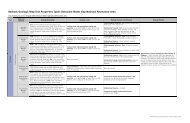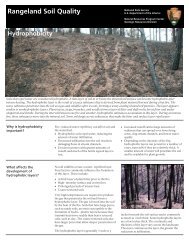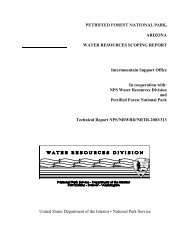Naphthalene, C1 - National Park Service
Naphthalene, C1 - National Park Service
Naphthalene, C1 - National Park Service
You also want an ePaper? Increase the reach of your titles
YUMPU automatically turns print PDFs into web optimized ePapers that Google loves.
planktonic algae as alkylation of the naphthalene<br />
structure increases [366, Jensen K et al; Limnol 15<br />
(2): 581-4 (1984)]. Comparing several parent<br />
compound PAHs (including naphthalene) to alkyl PAH<br />
counterparts, the methylated compounds were most<br />
toxic [366, Jensen K et al; Limnol 15 (2): 581-4<br />
(1984)].<br />
Although there is less toxicity information<br />
available for most of the alkyl PAHs than for their<br />
parent compounds, most alkyl PAHs appear to be at<br />
least as toxic or hazardous as the parent compound.<br />
As can be seen from the preceding paragraph, some<br />
have been documented to be more toxic.<br />
Total naphthalenes (total NPHs): Until more<br />
complete information on the effects of all the<br />
alkyl naphthalenes is available, risk assessment<br />
experts suggest adding all alkyl naphthalene<br />
concentrations plus the parent compound<br />
concentration and comparing the sum to known<br />
toxicological effects benchmarks and criteria for<br />
the respective parent compound (Bill Stubblefield,<br />
ENSR, personal communication, 1995). In this<br />
method, naphthalenes are the sum of C0-C4<br />
naphthalenes (total NPHs) [521]. In other words,<br />
the concentration of total naphthalenes is the sum<br />
of the following concentrations: total <strong>C1</strong><br />
naphthalenes (including all methyl naphthalenes) +<br />
total C2 naphthalenes (including<br />
dimethylnaphthalenes) + total C3 naphthalenes<br />
(including trimethyl naphthalenes) + total C4<br />
naphthalenes + C0 (naphthalene parent compound<br />
concentration). C0-C4 naphthalenes are typically<br />
identified in expanded scans [828].<br />
One study indicated that pure naphthalene and<br />
alkylnaphthalenes are from 3 to 10 times more toxic<br />
to test animals than are benzene and alkylbenzene<br />
[770]. However, another source states that<br />
naphthalene and its homologous series are less<br />
acutely toxic than benzene, but prevalent for a<br />
longer period during oil spills [773].<br />
At the initial stages of the release of<br />
naphthalene- and benzene-derived compounds, when<br />
these compounds are present at their highest<br />
concentrations, acute toxic effects are most<br />
common. Noncarcinogenic effects include subtle<br />
changes in detoxifying enzymes and liver damage<br />
[773].<br />
The heavier (4-, 5-, and 6-ring) PAHs are more<br />
persistent than the lighter (2- and 3-ring) PAHs,

















